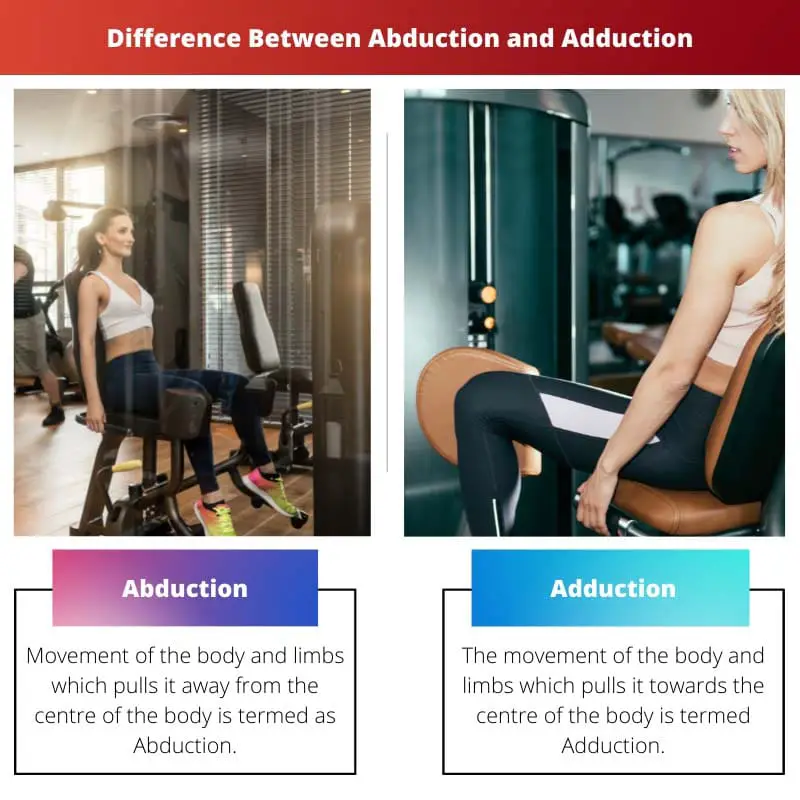Anatomy deals with the structure and structural organization of living beings. It is categorised as a branch of natural science. Anatomy is a very ancient science and has been used since the prehistoric period.
Key Takeaways
- Abduction is the movement of a body part away from the body’s midline, while Adduction is the movement of a body part towards the midline.
- Abduction is used to describe movements in the limbs, while Adduction can also describe movements in the fingers and toes.
- Abduction and Adduction are opposite movements and are essential in body mechanics, especially in sports that require extensive limb use.
Abduction vs Adduction
The difference between Abduction and Adduction is the movement in a direction with respect to the midline or centre of the body. A midline is an imaginary line that is used to divide the body into two parts from left to right, head to toe. Midline also means it is the centre of a body. Abduction is the motion that happens when the body moves away from the centreline. Adduction is the motion when the body moves towards the centerline.

Abduction is a concept related to anatomy. It shows the motion of the body or anatomical structure that is away from the midline.
Adduction is also related to anatomy and physiology. It shows the motion of the body towards the midline. It means the movements of our body parts are inside.
Comparison Table
| Parameters of Comparison | Abduction | Adduction |
|---|---|---|
| Causes | Abductors are responsible for abduction. | Adductors are responsible for adduction. |
| Leg Muscles | In this, thighs are spread. | In this, thighs are moved inwards. |
| Arm Muscles | It takes place in Supraspinatus and Deltoid. | It takes place in pectoralis major and Latissimus dorsi. |
| Anatomical Structures | It involves short fibres. | It involves long fibres. |
| Hand and Foot Muscles | Fingers and Toes move apart. | Fingers and toes move together. |
What is Abduction?
Movement of the body and limbs, which pulls it away from the centre of the body, is termed Abduction. When the hands are swung higher or taken up to the shoulders, the abduction process occurs.
When the hands are far away from the wrist and the centre of the body, then it is called radial deviation. When hands move apart, it is a radial styloid.
It takes place in the shoulder when a person raises their arms and moves far away to the sides. In hips, also when a person raises the legs and moves it far away out to the sides, then abduction happens.
What is Adduction?
The movement of the body and limbs, which pulls it towards the centre of the body, is termed Adduction. A contraction in the toes and fingers moves towards the body via the help of the adductor’s muscles.
Adductors Magnus and Brevis have a greater force. For the adduction of the fingers, palmar interossei are responsible. For arms, the latissimus dorsi is responsible, which is also a back muscle of our body.
For the movement of the big toe, adductor hallucis is responsible. For spreading toes, plantar interossei also play an important role.
Main Differences Between Abduction and Adduction
- Abduction involves short fibres in length. Adduction involves long fibres in length that have a greater force.
- Fingers and Toes move apart in Abduction. Fingers and toes move together in Adduction.

- https://www.sciencedirect.com/science/article/pii/S1051044307613086
- https://www.sciencedirect.com/science/article/pii/S002192900100080X

The detailed explanation of the leg and arm muscles involved in abduction and adduction is particularly enlightening.
The article has done a great job in differentiating the movements of abduction and adduction in various parts of the body.
Agreed. The clarity in presenting the differences in muscle involvement for these movements is commendable.
The inclusion of detailed explanations and main differences between abduction and adduction makes this article a very insightful piece for anyone wanting to understand these anatomical movements better.
This article is truly informative and provides clear insights into the concepts of abduction and adduction. It’s an essential read for those interested in anatomy.
Thank you for this great explanation of the concept of abduction vs adduction and the differences between them.
Yes, this article is very informative. It’s important to understand these concepts in anatomy.
The article effectively highlights the differences between abduction and adduction in terms of muscle movements and anatomical structures, enhancing the comprehension of these concepts.
Absolutely. The article’s detailed description of the hand and foot muscles involved in abduction and adduction provides valuable knowledge for those studying human anatomy.
Understanding the anatomical movements of abduction and adduction helps to comprehend various sports and physical activities better. This article provides clear and detailed explanations of these concepts.
Agreed. The comparison table is especially helpful in highlighting key differences between abduction and adduction.
The differentiation of the movements involved in abduction and adduction in the arms, legs, hands, and feet is well-explicated in this article.
I completely agree. The level of detail in this article is excellent in explaining the anatomical differences between abduction and adduction.
Absolutely, and the article’s explanation of the primary muscles responsible for these movements enhances our understanding of the concept.
The comparison of the causes and muscle involvement in abduction and adduction is very detailed and informative.
Absolutely. The article provides a comprehensive analysis of the differences between abduction and adduction in various body parts.
Yes, the description of the anatomical structures and muscle groups involved is very significant in understanding abduction and adduction.
The descriptions of both abduction and adduction are very clear and help in understanding the anatomical movements in the human body.
Indeed, the article provides valuable insights into the main differences between abduction and adduction. This information is crucial for those studying anatomy.
The concept of abduction and adduction is fundamental to human anatomy. This article has presented the information in a very comprehensive manner.
This article’s comprehensive descriptions and clear definitions of abduction and adduction are highly valuable for anyone interested in understanding human anatomy.